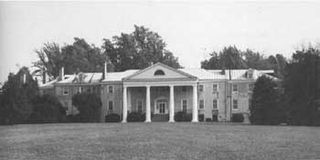
James Madison's Montpelier, located in Orange County, Virginia, was the plantation house of the Madison family, including Founding Father and fourth president of the United States James Madison and his wife, Dolley. The 2,650-acre (10.7 km2) property is open seven days a week with the mission of engaging the public with the enduring legacy of Madison's most powerful idea: government by the people.

The Belair Mansion, located in the historic Collington area and in Bowie, Maryland, United States, built c. 1745, is the Georgian style plantation house of Provincial Governor of Maryland, Samuel Ogle. Later home to another Maryland governor, the mansion is listed on the National Register of Historic Places.
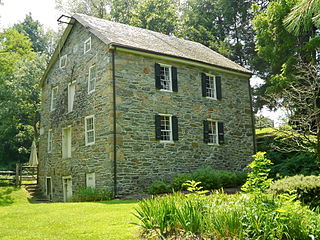
The Mill Green Historic District is a National Register of Historic Places listed community located in Harford County, Maryland. The district consists of a small cluster of privately owned historic homes and buildings including a historic mill. The district is located at the junction of Mill Green Road and Prospect Road. Broad Creek flows through the district. The historic district designation was established in 1993.

Darnall's Chance, also known as Buck House, Buck-Wardrop House, or James Wardrop House, is a historic home located at 14800 Governor Oden Bowie Drive, in Upper Marlboro, Prince George's County, Maryland, United States.

The Franklin and Armfield Office, which houses the Freedom House Museum, is a historic commercial building in Alexandria, Virginia. Built c. 1810–1820, it was first used as a private residence before being converted to the offices of the largest slave trading firm in the United States, started in 1828 by Isaac Franklin and John Armfield. "As many as [a] million people are thought to have passed through between 1828 and 1861, on their way to bondage in Mississippi and Louisiana". Another source, using ship manifests in the National Archives, gives the number as "at least 5,000".

Fairview Plantation was built around the year 1800 by Baruch Duckett in Collington, Maryland. The house is a transitional federal/Greek revival design considered to be a significant part of the Prince George's County heritage. Fairview is a two-story stuccoed brick plantation house with flush end chimneys and a unique stepped gable at one gable end. Its Georgian plan interior features fine Federal style trim.

Holy Trinity Episcopal Church in Collington, Maryland is a historic place of worship dating back more than three centuries. Originally a chapel of ease for Queen Anne Parish, it became a separate parish in 1844.

Cliveden, also known as the Chew House, is a historic site owned by the National Trust for Historic Preservation, located in the Mount Airy neighborhood of Northwest Philadelphia. Built as a country house for attorney Benjamin Chew, Cliveden was completed in 1767 and was home to seven generations of the Chew family. Cliveden has long been famous as the site of the American Revolutionary War's Battle of Germantown in 1777 as well as for its Georgian architecture.

Oxon Cove Park and Oxon Cove Farm is a national historic district that includes a living farm museum operated by the National Park Service, and located at Oxon Hill, Prince George's County, Maryland. It is part of National Capital Parks-East. It was listed on the National Register of Historic Places in 2003.

Riversdale, is a five-part, large-scale late Georgian mansion with superior Federal interior, built between 1801 and 1807. Also known as Baltimore House, Calvert Mansion or Riversdale Mansion, it is located at 4811 Riverdale Road in Riverdale Park, Maryland, and is open to the public as a museum.

Bellefields is a manor house located in Croom, Prince George's County, Maryland. It was constructed about 1720. It is a brick structure in Flemish bond with random glazed headers, and two stories over a high basement. The structure is rectangular, with gabled roof sections, paired interior end chimneys, a front center entrance, wide raised belt course above the first floor, flat arched openings, and flanking symmetrical single-story wings. It is in the Georgian style. It was the home of Patrick Sim, Scottish immigrant and of his son, Col. Joseph Sim, Maryland patriot.

Sunnyside is a historic home located in Aquasco, Prince George's County, Maryland, United States. It is a five bay wide two-story frame house with a center hall and north and south parlors, facing east on a brick foundation. The building dates to 1844. The main block of the house is a fine example of a mid-19th century I-house, and possesses a great deal of intact original fabric. The significance of the property is enhanced by the 18th century wing, in good repair and possessing its original hearth with iron fittings. The house and outbuildings are well preserved examples of vernacular southern Maryland architecture dating from the 18th through the mid 19th century.

Bowieville is a historic home located near Upper Marlboro in Prince George's County, Maryland, United States. It is an elegant two-part plantation house of the late Federal style, built of brick and covered with stucco. The architectural detail is transitional between the Federal and Greek Revival styles.
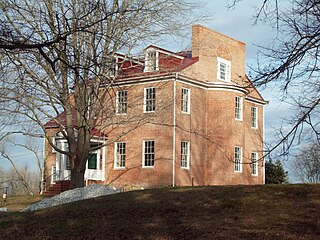
Melford is a historic plantation house located on the grounds of the Maryland Science and Technology Center, near the intersection of U.S. Route 301 and U.S. Route 50, at Bowie, Prince George's County, Maryland. The house is multi-part, gable-roofed, brick and stone dwelling house constructed probably in the mid-late 1840s, with elements of the Greek Revival style.

Pleasant Prospect is a historic home located at Mitchellville, Prince George's County, Maryland. It is an outstanding and important example of a Federal style plantation house, consisting of a 2½-story main structure over a full basement with a 2-story kitchen linked by a 1-story hyphen. The kitchen wing and hyphen are typical of late eighteenth century ancillary architecture in Southern Maryland. The walls are laid in Flemish bond, and the chimneys are typical of Maryland; wide on the side, thin and high above the ridge, rising on the gable ends of the house flush with the building wall. The interior exhibits outstanding Federal style trim, including elaborate Adamesque moldings and plasterwork ornamentation such as garlands, swags, and urns applied to interior doorways and mantles. A pyramidal roof, log meat house stands on the immediate grounds.

Grassland is a historic house at Annapolis Junction, Anne Arundel County, Maryland. It was built in 1853, and is a three-part brick structure constructed in a telescoping manner. Other structures on the property were erected between 1852 and 1854 by enslaved people: the one-story frame slave house with brick-nogged walls; a small stone smokehouse; the remains of a summer kitchen; and a frame harness shed, storage shed, and the ruins of a bank barn.

Caleb Bentley (1762–1851) was an American silversmith, shopkeeper, and first postmaster in Brookeville, Maryland. Bentley was born in Chester County, Pennsylvania in 1762.
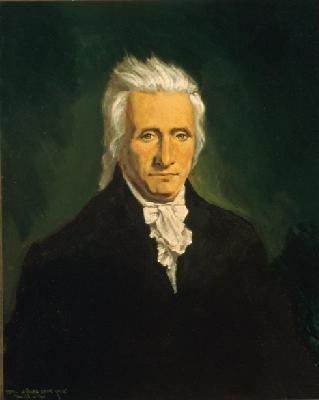
Gabriel Duvall was an American politician and jurist. Duvall was an Associate Justice of the Supreme Court of the United States from 1811 to 1835, during the Marshall Court. Previously, Duvall was the Comptroller of the Treasury, a Maryland state court judge, a member of the U.S. House of Representatives from Maryland, and a Maryland state legislator.

DuVal High School (DHS) is a comprehensive science and technology public magnet high school in the Seabrook census-designated place in unincorporated Prince George's County, Maryland, United States, with a Lanham postal address. Prior to 2010 the U.S. Census Bureau defined the area containing DuVal High as being within the Goddard CDP.
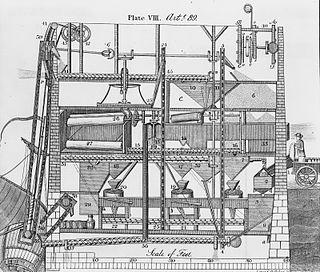
Roxbury Mill is a historic flour and grist mill located in Glenwood, Howard County, Maryland, now part of the Howard County Farm Museum.


























